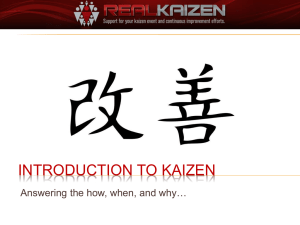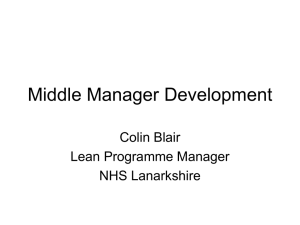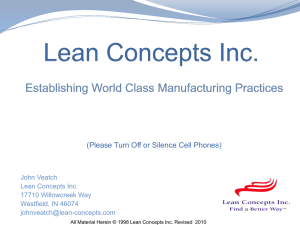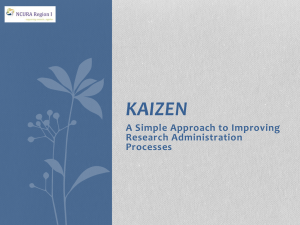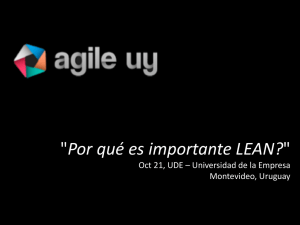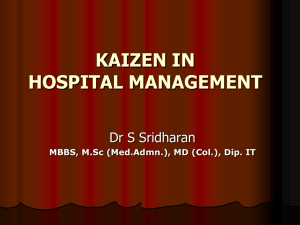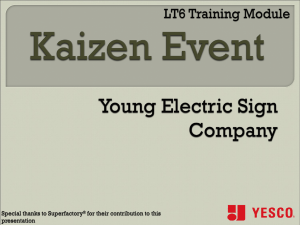2013-Presentation-Leavitt - Performance Excellence Network
advertisement
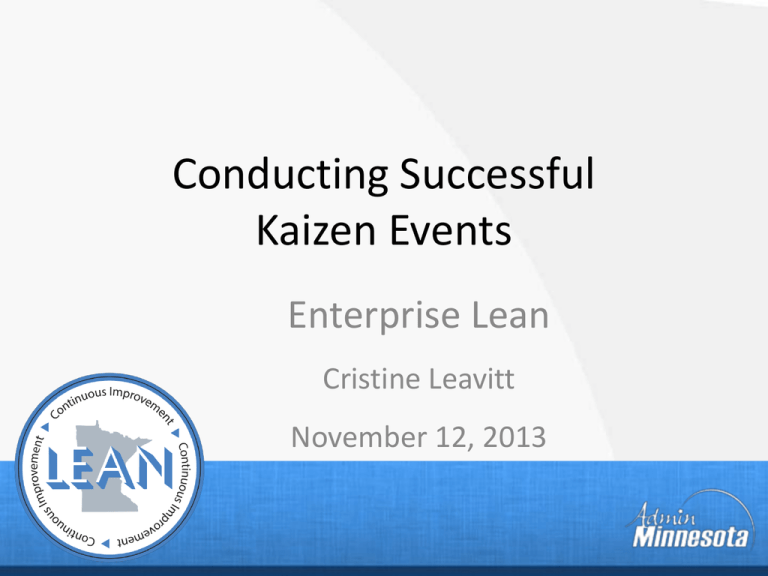
Conducting Successful Kaizen Events Enterprise Lean Cristine Leavitt November 12, 2013 Learning Objective • Learn the steps and tips for planning and conducting a successful Kaizen event. Page 2 Agenda • What is a Kaizen event? • Planning the event • Holding the event and implementing changes • Monitoring results • Sustaining standard work and ensuring continuous improvement Plan Act DO Check Page 3 What is a Kaizen Event? Lean Transformation Strategy Leadership Performance Measures Training Project Portfolio 7 Wastes 5S Kaizen Standard Word Increasing Organizational Value • A 3-5 day facilitated event that engages a team to remove “waste” from a process. Planning Phase Select Project 1. 2. 3. 4. 5. 6. Define Scope Set Goals Engage Team Schedule Meetings Collect Info. Hold Kickoff Select the project (define the business issue) Define project scope Set goals & complete a project charter Define and prepare the team Schedule meetings Collect information and data Communicate! Communicate! Communicate! 5 1. Select the Project Select Project Define Scope Set Goals Engage Team Schedule Meetings Collect Info. Hold Kickoff Consider the following criteria: • Alignment • Impact • Need • Willingness • Ability 6 Improvement Project Types 7 Defining Project Type 8 Project Selection Tips • Clear start and end points (can be described as a process) • Easily identifiable internal and external customers • Improvement can be measured • Start with quick wins before tackling larger projects 9 2. Scope the Project Select Project Define Scope Set Goals Engage Team Schedule Meetings Collect Info. Hold Kickoff • Define what is IN scope – What is the first step of the process? – What is the last step? • Define what is OUT of scope 10 Scoping Tips • How big is too big? (rule of thumb; if there are 10 or more functions, reduce the scope) • Adjust the scope if you do not have the current state process documented by mid-morning of Day 2 • Use a SIPOC diagram Supplier Inputs Process Outputs Customer 11 3. Set Goals & Complete a Project Charter Select Project Define Scope Set Goals Engage Team Schedule Meetings Collect Info. Hold Kickoff • Establish SMART goals (time, defects, FPY) • Set the bar high! (50% reduction in lead time) • Goals should be clear, and easy to communicate • Goals should be set by the project sponsor • Complete a project charter 12 A3 – Project Charter 13 4. Define and Prepare the Team Select Project Define Scope Set Goals Engage Team Schedule Meetings Collect Info. Hold Kickoff Team Roles: 1. Sponsor 2. Team leader 3. Facilitator 4. Team members Commitment is needed from everyone! 14 Sponsor Responsibilities • Create or ratify project scope and goals • Select the team leader, facilitator, and team members (often with team leader) • Invite team members and communicate project to key stakeholders – transparency is key! • Kickoff the event with words of support • Stay involved with the team and attend check-in meetings at the end of each day • Attend final presentation and recognize team • Ensure improvements are implemented and sustained 15 Team Leader Responsibilities • Assist on scope, goals, and defining team members • Gather process information and data • Schedule kickoff and event meetings and venues • Help the facilitator with team member involvement • Lead check-in meetings • Coordinate implementation of action plan • Trouble shoot and bring issues to sponsor’s attention • Monitor progress and performance • Ensure standard work is followed and sustained and results achieved 16 Facilitator Responsibilities • Help the sponsor and team leader define and prepare for the kaizen event • Facilitate the event • Train on Lean principles and tools • Work with the team to provide deliverables • Support implementation and sustainment 17 Team Member Responsibilities • Knowledge and expertise on the current process (may also want a person from outside of the process to provide a fresh perspective) • Use data to understand and solve problems • Ability and willingness to participate – are they open to change or a CAVE dweller? • Create and abide by team ground rules • Develop project deliverables (future state process, action plan, report out presentation) • Implement action plan and sustain improvements 18 5. Schedule Meetings Select Project Define Scope Set Goals Engage Team Schedule Meetings Collect Info. Hold Kickoff • Reserve rooms and peoples schedules 4-6 weeks prior to the event (including Kick-off meeting) • Event venue criteria: – – – – Isolated - quiet for work and not disturbing others Lots of available wall space Technology for training Provides access to process materials and resources 19 6. Collect Information and Data Select Project Define Scope Set Goals Engage Team Schedule Event Collect Info. Hold Kickoff Team leader collects process data: • Volumes (# processed per month, year) • Current metrics relevant to the process (time, first pass yield, rework, customer satisfaction) • Forms/databases used in the process • Defects – External, re-work • Customer needs and requirements (CTQ) 20 7. Hold Kick-Off Meeting Select Project Define Scope Set Goals Engage Team Schedule Event Collect Info. Hold Kickoff Purpose: Get everyone on the same page • Sponsor Kickoff (business issue and anticipated customer and staff benefits) • Review project charter & roles and responsibilities • Answer questions • Sign Project Commitment 21 Communicate! • Identify key audiences for the project and what they may need or want to know and how best to deliver the information – Eg: Let leaders and staff know that you are engaging a team to recommend changes to improving the process; share the process goal and timeline; who is involved, and who they may contact with questions, concerns and advice. Communicate before, during and after the event 22 Planning Advice • Use a project charter and sign charter • Do not use a kaizen event to address employee performance issues • Include someone from outside the process on the team • Clarify team member time commitment before, during & after • Educate/coach sponsors to manage their expectations • Solicit input from staff and stakeholders upfront • Provide an avenue to report concerns, questions, and improvement ideas before, during and after the project • Publicize the project – it shouldn’t be a secret! • Provide sponsor check-ins to obtain guidance and avoid zingers! 23 Event & Implementation Phase 1. Map and characterize the current state process 2. Observe the process (e.g. strengths and weaknesses/wastes) 3. Brainstorm improvements 4. Map and characterize the future state process 5. Create an action plan 6. Set performance measures 7. Share results with stakeholders 8. Implement the action plan 24 1. Map & Characterize the Current State Process People (job functions) 25 2. Observe the Process Strengths • Where does the process work well? • What are value-added steps? Weaknesses (OFI) • Where are the 7 wastes? 1. Overproduction 2. Waiting 3. Transportation 4. Extra processing 5. Inventory 6. Motion 7. Defects * Underused creativity! 26 3. Brainstorm Improvements • List lots of ideas (big, bold ideas - no cost ideas) • Rank and prioritize ideas • Select ideas to include in future state process High Impact / Low $ High Impact / High $ Low Impact / Low $ Low Impact / High $ 27 4. Map & Characterize the Future State Process Current State Quantity Time Future State Quantity Tasks Waits Handoffs File/Store Decisions Totals % Change = (Current hours – Future hours)/Current hours) x 100 • [ ] % reduction in lead time • [ ] % reduction in task time Time 5. Create an Action Plan What Who When Status 1. 2. 3. 4. 29 6. Set Performance Measures • If you do not have performance measures, create performance measures during the event. • Track performance on a regular basis to see whether you are achieving expected performance levels. • Use both qualitative and quantitative measures (critical 2-4 measures). • Use visual measures to quickly communicate progress, enhance standard work, and facilitate issue identification and resolution. • Typical measures: Lead time, FPY, # errors/defects 30 7. Share Results with Stakeholders • Hold a report out presentation where team members present project goals and recommended changes to key stakeholders • Ask questions • Celebrate! 31 8. Implement the Action Plan • Include in your action plan how and when you will monitor performance. • Have a strategy for identifying and resolving issues, including resistance 32 Event and Implementation Advice • • • • • • • • • Create & enforce team ground rules Provide just-in-time training Reduce the project scope - if you need to Prioritize ideas based on impact & ease of implementation ($) Provide snacks and have fun during the event! Make the action plan accessible and easy to change and name the person who will complete each task Expect and plan for challenges Hold yourself and others accountable Reward and recognize people for bringing up issues 33 Monitoring Phase • 30, 60, & 90-day status meetings with sponsor • Validate whether changes achieved project goals • Document future state process • Manage resistance 34 Monitoring Advice • Hold weekly or daily action plan status meetings • The sponsor should assure that the action plan is being implemented • If the team runs into resistance that has stalled their efforts the sponsor needs to get involved – go to the Gemba (See, Ask, Lean, Show Respect) • Monitor the demeanor of staff – are they energized or disheartened? • Focus action plan discussions on yellow and red status tasks 35 Continuous Improvement Phase • Adopt, adapt, or abandon the approach. • Document the future process and centrally store process maps – transfer process sustainment to process owner • Include in the action plan how and when you will review the process. • At least annually revisit the process to assess opportunities for improvement (OFIs). 36 Continuous Improvement Advice • Sustaining improvement is often the most difficult part – make sure people do not slip back to the “old way of doing things” • Expect to improve a process multiple times (35 times) to remove wastes and get closer to the “Ideal” 37 Kaizen Event Results Kaizen Event Results SSB: Assistive & Reduced technology evaluation assessment from 70 to 19 days (73% time reduction), 66% reduction in forms, standardized report forms, developed standard definitions, and enhanced supervisor ability to track progress and troubleshoot. Adaptive Technology Kaizen Event TAA Projects: 1) Customer Application Kaizen, 2) Purchase & Payment Redesign UI: Customer Service Center Kaizen (General Mills & DEED) UI: Phone Agent Problem Solving Project (General Mills & DEED) • Kaizen: reduced application process from 83 to 39 days (53%). • Redesign: reduced purchase/payment from 72 to 38 days (47%). • Reorganized customer caseloads, formalized internal discussions on unusual customer cases, improved policy development process, improved training process. Eliminated duplicate requests for status updates from the Customer Service Center staff and resulted in reducing status updates from 25 days to 1 day (96% time reduction) Fishbone analysis: 50% reduction in supervisor time spent bringing additional agents on line (saved 2500 hours per year). 38 For More Information • Enterprise Lean ‒ Dept. of Administration, State of Minnesota ‒ MN.gov/Lean | Lean@state.mn.us • Mary Jo Caldwell |Director of Enterprise Lean ‒ Office: 651.201.2560 | Mary.Jo.Caldwell@state.mn.us • Cristine Leavitt | Lean Expert ‒ Office: 651.201.2567 | Cristine.Leavitt@state.mn.us 39


